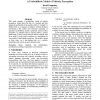Free Online Productivity Tools
i2Speak
i2Symbol
i2OCR
iTex2Img
iWeb2Print
iWeb2Shot
i2Type
iPdf2Split
iPdf2Merge
i2Bopomofo
i2Arabic
i2Style
i2Image
i2PDF
iLatex2Rtf
Sci2ools
COGSCI
2008
2008
A Probabilistic Model of Melody Perception
This study presents a probabilistic model of melody perception, which infers the key of a melody and also judges the probability of the melody itself. (A "melody" is defined here as a sequence of pitches, without rhythmic information.) The model uses Bayesian reasoning. A generative probabilistic model is proposed, based on three principles: 1) melodies tend to remain within a narrow pitch range; 2) note-to-note intervals within a melody tend to be small; 3) notes tend to conform to a distribution (or "key-profile") that depends on the key. The model is tested in three ways: on a key-finding task, on a melodic expectation task, and on an error-detection task.
Related Content
| Added | 09 Dec 2010 |
| Updated | 09 Dec 2010 |
| Type | Journal |
| Year | 2008 |
| Where | COGSCI |
| Authors | David Temperley |
Comments (0)

